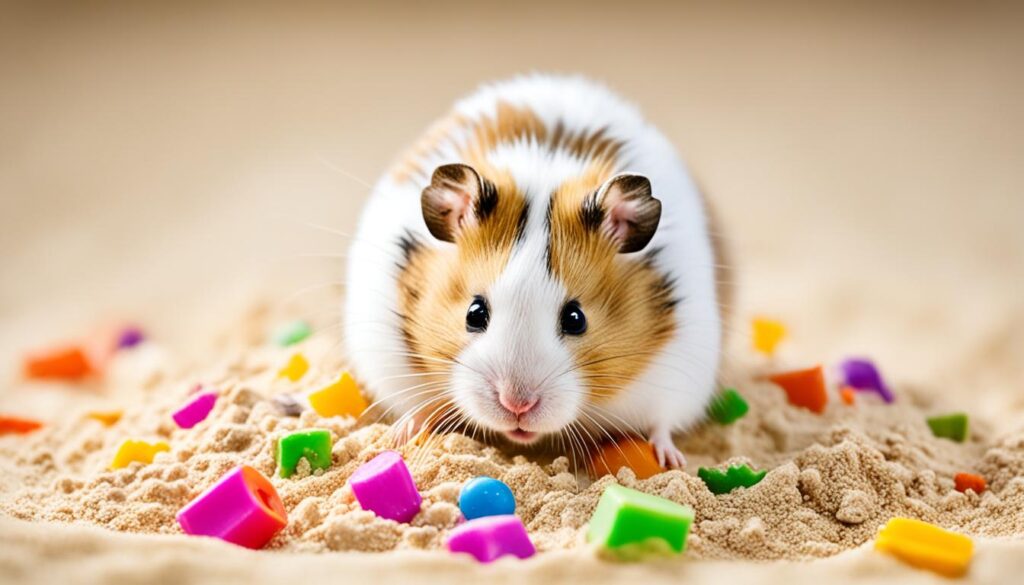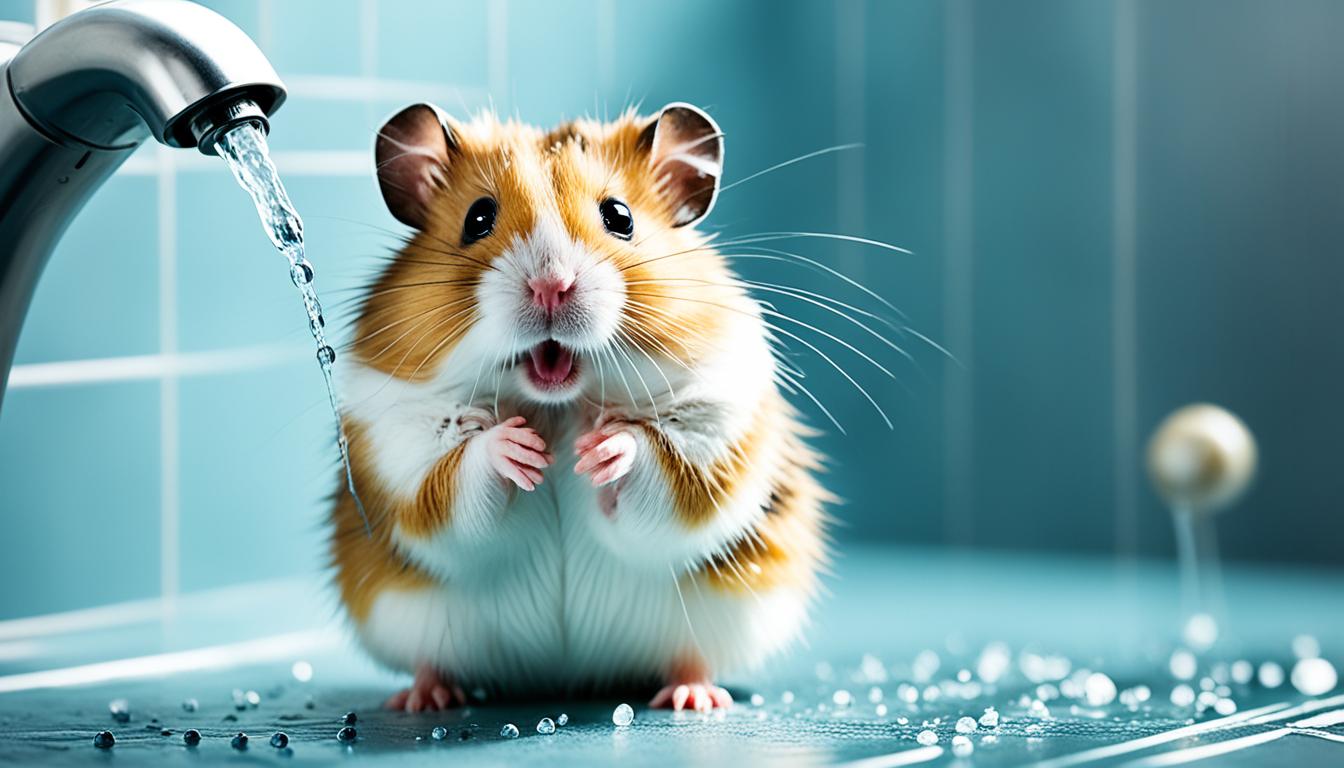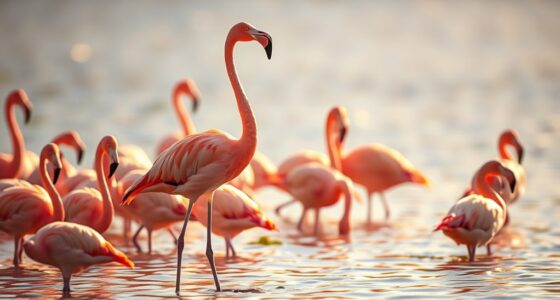Did you know that hamsters are not naturally equipped to handle water like other animals? Despite their cuteness, hamsters can face serious risks when exposed to water. Although they can technically swim, intentionally wetting a hamster is not advised as it can have detrimental effects on their health and well-being.
Hamsters have thick fur that naturally contains oils to protect them from the elements. If a hamster’s coat gets soaking wet, it removes some of the protective oils and renders the coat ineffective. This can lead to the hamster being unable to regulate its temperature and potentially experiencing hypothermia. Additionally, hamsters are prone to stress, and being forced to swim can cause them extreme anxiety and distress.
In this article, we will explore why hamsters should not swim, how to keep them clean without water, what to do if your hamster accidentally gets wet, and the importance of keeping them dry to ensure their health and happiness.
Key Takeaways:
- Hamsters are not naturally equipped to handle water and can face negative consequences if they get wet intentionally.
- Wet fur removes the protective oils from a hamster’s coat, making it difficult for them to regulate their body temperature and potentially leading to hypothermia.
- Hamsters are prone to stress, and swimming can cause them extreme anxiety and distress.
- Avoid immersing hamsters in water and instead provide them with a sand bath for cleaning their fur.
- If your hamster accidentally gets wet, take immediate action to dry them off and provide a warm environment for them to recover.
Why Shouldn’t Hamsters Swim?
There are several reasons why hamsters should not be encouraged or forced to swim. Firstly, hamsters do not have any desire to swim, so there is no benefit in the activity for them. Unlike some other rodents, hamsters are not natural swimmers. They are native to dry areas and do not have the physique or instinct for swimming.
Additionally, hamsters are prone to stress, and swimming can be a highly stressful experience for them. It can trigger their fight-or-flight response, putting them in a state of danger and distress.
Furthermore, hamsters have a thick, fluffy coat that contains oils to protect them from temperature changes. If their coat gets soaked, these oils are removed, leaving them unable to regulate their body temperature properly. This can lead to their body temperature dropping rapidly and potentially causing death.
To summarize, hamsters should not swim due to the lack of desire and natural ability, the potential for stress and distress, and the negative effects of water on their body temperature regulation. It is best to provide a safe and dry environment for hamsters to keep them healthy and happy.
| Reasons Hamsters Should Not Swim | Negative Effects of Water on Hamsters |
|---|---|
| Hamsters do not have any desire to swim | Coat loses protective oils, leading to temperature regulation issues |
| Swimming causes stress and distress in hamsters | Potential for rapid body temperature drop and hypothermia |
How to Bathe Your Hamster
While it is not recommended to immerse a hamster in water, there are still ways to keep them clean. Hamsters do not need to be bathed in water, but they do require a sand bath. A sand bath is an area in their cage or tank filled with sand where they can roll around and clean their fur. Reptile sand or play sand can be used for this purpose. It is important to ensure that the sand is fine but not dusty and does not contain any harmful substances like calcium.
A hamster should not be bathed in water unless absolutely necessary. If there is something stuck to their fur, it can be spot-cleaned with a clean towel soaked in warm water. Care should be taken to keep the water off their skin and avoid penetrating the lower layers of their fur coat.
| Steps for Bathing a Hamster | Benefits |
|---|---|
| 1. Prepare a sand bath by filling a shallow container with reptile sand or play sand. | 1. Allows hamsters to clean their fur naturally, removing dirt and excess oils. |
| 2. Place the sand bath in their cage or tank, ensuring it is easily accessible to your hamster. | 2. Provides mental stimulation and a natural grooming behavior for hamsters. |
| 3. Allow your hamster to explore and roll in the sand bath at their leisure. | 3. Prevents the removal of natural oils from their fur, maintaining their coat’s protective properties. |
| 4. Monitor the sand bath regularly and replace the sand when necessary. | 4. Reduces the risk of skin irritation or matting caused by dirty or dusty fur. |
By providing your hamster with a sand bath, you can ensure they stay clean and maintain a healthy coat. Remember to choose sand that is safe and suitable for hamsters, and avoid bathing them in water unless it is absolutely necessary to spot-clean their fur.

What to Do if Your Hamster Gets Wet
If your hamster accidentally gets wet, immediate action should be taken to dry them off and prevent any potential health issues. Follow these steps to ensure your hamster’s well-being:
- Dry their fur: Start by using an absorbent towel to gently pat their fur dry. Avoid any unnecessary stress and be gentle while drying. This will help remove moisture from their fur and prevent further chilling.
- Use a blow-dryer: If your hamster is still wet, you can use a blow-dryer on the lowest heat setting. Hold it at a safe distance from the hamster and continuously move it to avoid overheating or causing discomfort.
- Provide a warm environment: It is vital to create a warm environment for your hamster to recover from being wet. You can achieve this by placing them against your skin, which will offer natural warmth. Alternatively, you can use a reptile heating pad or a hot water bottle (ensuring it is not too hot) placed near their cage to provide warmth.
- Remove water from the cage: Make sure to remove any water from their cage, including water bowls and bottles. Replace the water with slightly warm water to prevent a sudden drop in temperature.
- Insulate their cage: To keep your hamster warm, you can insulate their cage with a blanket. Warm the blanket in the dryer to provide extra coziness and help maintain their body temperature.
- Allow rest and recovery: Give your hamster time to rest and recover. Avoid disturbing them and allow them to come out on their own when they feel ready.

By taking these actions, you can effectively dry your hamster, prevent hypothermia, and ensure their well-being after getting wet. Remember, swift and appropriate measures are essential to keep your furry friend comfortable and happy.
Hamsters and Water Don’t Mix
When it comes to hamsters, water can have negative effects that range from stress and discomfort to serious health issues. Hamsters are not naturally inclined to swim, and exposing them to water can cause unnecessary distress. Wet fur poses several dangers to hamsters, including the loss of protective oils. These oils play a crucial role in regulating body temperature, and when they are washed away, it becomes difficult for hamsters to maintain their internal warmth. This can lead to hypothermia and, in severe cases, even death.
Moreover, wet fur provides an ideal environment for bacteria and fungi to thrive. This invites the risk of skin infections and irritations, which can further compromise the well-being of hamsters. Therefore, it is of utmost importance to prioritize keeping hamsters dry to prevent the onset of such complications.
“The negative effects of water on hamsters can lead to stress, discomfort, and even serious health issues.”
Regular spot-cleaning with a sand bath is sufficient for maintaining the hygiene of hamsters. Not only does a sand bath prevent the need for immersing them in water, but it also allows them to engage in natural grooming behavior. The sand helps to remove any dirt or debris from their fur, keeping it clean and healthy. The sandy texture also helps to absorb excess moisture and oils, preventing the fur from becoming excessively wet.
The Dangers of Wet Fur
Wet fur not only affects a hamster’s ability to regulate body temperature but also increases the risk of developing respiratory issues. When a hamster’s fur is wet, it becomes heavier and clumps together, making it difficult for them to move and breathe properly. This can lead to labored breathing and increased susceptibility to respiratory infections and other ailments.
“The importance of keeping hamsters dry extends beyond temperature regulation; it also helps prevent respiratory issues.”
Preventing hamsters from becoming wet is essential for their overall well-being and health. Avoid exposing them to water, and refrain from activities such as swimming or wetting them intentionally. By prioritizing their dryness, you can ensure their happiness and longevity as cherished pets.

| Dangers of Wet Fur in Hamsters | Importance of Keeping Hamsters Dry |
|---|---|
| 1. Loss of protective oils | 1. Proper temperature regulation |
| 2. Increased susceptibility to hypothermia | 2. Prevention of respiratory issues |
| 3. Risk of skin infections | 3. Maintaining overall health and well-being |
Conclusion
In conclusion, while hamsters can technically get wet, it is not recommended to intentionally expose them to water. Hamsters are not natural swimmers, and swimming can cause them extreme stress and health issues. Wet fur can lead to the loss of protective oils, temperature regulation problems, and potentially fatal hypothermia.
It is best to keep hamsters dry and provide them with a sand bath for cleaning their fur. A sand bath allows hamsters to maintain their hygiene without the need for water immersion. The sand helps remove dirt and excess oil from their fur, keeping them clean and comfortable.
If a hamster does get wet accidentally, immediate action should be taken to dry them off and prevent any potential health issues. Gently pat their fur dry with an absorbent towel and use a blow-dryer on the lowest heat setting, keeping a safe distance. Providing a warm environment and removing any water from their cage will help them recover.
By following these safety tips and understanding the risks associated with water exposure, you can ensure the well-being and happiness of your pet hamster. Keeping them dry and implementing a regular sand bath routine will help maintain their overall health and hygiene.










